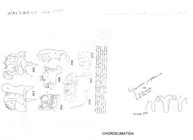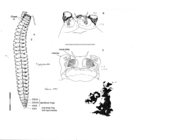MilliBase
MilliBase name details
Craspedosoma polydesmoides Leach, 1814
948509 (urn:lsid:marinespecies.org:taxname:948509)
unaccepted
Species
Leach, W.E. (1813-1815). Crustaceology. <em>In: Brewster, D. (ed.), The Edinburgh Encyclopaedia. Balfour, Edinburgh, vol. 7(1): 383–384 [1813], 7(2): 385–437, 765–766 [1814], 9(1): pl. CCXXI [1815].</em> , available online at https://www.biodiversitylibrary.org/page/37187640
page(s): 407 [details]
page(s): 407 [details]
Sierwald, P.; Decker, P.; Spelda, J. (2025). MilliBase. Craspedosoma polydesmoides Leach, 1814. Accessed at: https://millibase.org/aphia.php?p=taxdetails&id=948509 on 2025-07-02
Date
action
by
original description
Leach, W.E. (1813-1815). Crustaceology. <em>In: Brewster, D. (ed.), The Edinburgh Encyclopaedia. Balfour, Edinburgh, vol. 7(1): 383–384 [1813], 7(2): 385–437, 765–766 [1814], 9(1): pl. CCXXI [1815].</em> , available online at https://www.biodiversitylibrary.org/page/37187640
page(s): 407 [details]
additional source Risso, A. (1826-1827). Histoire naturelle des principales productions de l'Europe Méridionale et particulièrement de celles des environs de Nice et des Alpes Maritimes. <em>[book series].</em> 400 pp., 13 pls. [volumes 1-5. Paris, F.G. Levrault. vol. 3. Mammifères. Oiseaux. Poissons / vol. 4. Mollusques. Annélides / vol. 5. Crustacés. Myriapodes, scorpionides, arachnides et acarides. Insectes. Vers intestinaux. Radiaires. Zoophytes]., available online at http://www.biodiversitylibrary.org/bibliography/58984
page(s): 151 [details]
additional source Lucas, H. (1840). Histoire Naturelle des Crustacés, des Arachnides et des Myriapodes. <em>P. Duménil, Paris.</em> 600 pp. + 46 plates (inclusive)., available online at http://biodiversitylibrary.org/page/30739516
page(s): 533 [details]
additional source Kurnik, I. (1988). Zur Taxonomie ostalpiner Chordeumatida: Vulvenmorphologie und Identifikation der Weibchen. Zoologische Jahrbücher, Abteilung für Systematik, Ökologie und Geographie der Tiere, 115: 229-302. Jena
page(s): 273; note: description of species [details]
additional source Wirkner, C. S.; Stagl, V.; Turk, N. (2002). The type specimens of the Chordeumatida in the Natural History Museum Vienna (Diplopoda). Katalog der wissenschaftichen Sammlungen des Naturhistorischen Museums in Wien, 16(1): 3-31. Wien, available online at https://www.zobodat.at/pdf/kat-nhmw_16_0001-0031.pdf
page(s): 18 [details]
additional source Schubart, O. (1960). Über einige Höhlen-Diplopoden der Schweiz und Frankreichs. Revue suisse de zoologie, 67: 561-588. Genève
page(s): 578 [details]
additional source Schubart, O.; Husson (1936). Les Diplopodes des cavités souterraines du nord-est de la France. Bulletin de la Société zoologique de France, 61: 484-502
page(s): 489 [details]
additional source Gervais, P. (1837). Études pour servir á l'histoire naturelle des Myriapodes. <em>Annales des Sciences naturelles, Zoologie, série 2, tome 7: 35-60, plate 4b.</em> , available online at https://www.biodiversitylibrary.org/page/2254777
page(s): 47 [details]
additional source Koch, C.L. (1847). Den Verzeichnissen und Berichtigungen zu Deutschlands Crustaceen, Myriapoden und Arachniden und ein System der Myriapoden. [The lists and corrections to Germany's crustaceans, myriapods and arachnids and a system of the myriapods.]. <em>In: Panzer, G.W.F. & Herrich-Schäffer, A. (eds.), Kritische Revision der Insectenfaune Deutschlands.</em> 3: 1-272, pls. 1-10., available online at http://biodiversitylibrary.org/page/33700094
page(s): 125 [details]
additional source Brandt, J. F. (1833). Tentaminum quorundam monographicorum Insecta Myriapoda Chilognathi Latreillii spectantium prodromus. Bulletin de la Societé Impériale des Naturalistes de Moscou, 6: 194-209. Moscow, available online at http://biodiversitylibrary.org/page/45989137
page(s): 206 [details]
additional source Demange, J.-M. (1965). Remarques sur quelques Myriapodes cavernicoles de France. Description d'une forme nouvelle du genre Metaiulus. Bulletin de la Société d'histoire naturelle de Toulouse, 100(3-4): 446-450
page(s): 446 [details]
additional source Leach, W.E. (1816 [1815]). A tabular View of the external Characters of Four Classes of Animals, which Linné arranged under Insecta, with the Distribution of the Genera comprising Three of these Classes into Orders &c. and Descriptions of several New Genera and Species. <em>The Transactions of the Linnean Society of London.</em> 11(2): 306-400., available online at http://biodiversitylibrary.org/page/756873
page(s): 380 [details]
source of synonymy Jeekel, C. A. W. (1971). Nomenclator generum et familiarum Diplopodorum: A list of the genus and family-group names in the Class Diplopoda from the 10th edition of Linnaeus, 1758, to the end of 1957. Monografieen van de Nederlandse Entomologische Vereniging, 5: 1-412. Amsterdam, available online at https://nev.nl/wp-content/uploads/2020/11/Mono-05-Jeekel-1970-OCR.pdf
page(s): 72 [details]
source of synonymy Brölemann, H. W. (1935). Myriapodes Diplopodes (Chilognathes I). Faune de France, 29: 1-369. Paris, available online at https://faunedefrance.org/bibliotheque/docs/H.W.BROLEMANN(FdeFr29)Myriapode.diplopodes1.pdf
page(s): 140-142 [details]
page(s): 407 [details]
additional source Risso, A. (1826-1827). Histoire naturelle des principales productions de l'Europe Méridionale et particulièrement de celles des environs de Nice et des Alpes Maritimes. <em>[book series].</em> 400 pp., 13 pls. [volumes 1-5. Paris, F.G. Levrault. vol. 3. Mammifères. Oiseaux. Poissons / vol. 4. Mollusques. Annélides / vol. 5. Crustacés. Myriapodes, scorpionides, arachnides et acarides. Insectes. Vers intestinaux. Radiaires. Zoophytes]., available online at http://www.biodiversitylibrary.org/bibliography/58984
page(s): 151 [details]
additional source Lucas, H. (1840). Histoire Naturelle des Crustacés, des Arachnides et des Myriapodes. <em>P. Duménil, Paris.</em> 600 pp. + 46 plates (inclusive)., available online at http://biodiversitylibrary.org/page/30739516
page(s): 533 [details]
additional source Kurnik, I. (1988). Zur Taxonomie ostalpiner Chordeumatida: Vulvenmorphologie und Identifikation der Weibchen. Zoologische Jahrbücher, Abteilung für Systematik, Ökologie und Geographie der Tiere, 115: 229-302. Jena
page(s): 273; note: description of species [details]
additional source Wirkner, C. S.; Stagl, V.; Turk, N. (2002). The type specimens of the Chordeumatida in the Natural History Museum Vienna (Diplopoda). Katalog der wissenschaftichen Sammlungen des Naturhistorischen Museums in Wien, 16(1): 3-31. Wien, available online at https://www.zobodat.at/pdf/kat-nhmw_16_0001-0031.pdf
page(s): 18 [details]
additional source Schubart, O. (1960). Über einige Höhlen-Diplopoden der Schweiz und Frankreichs. Revue suisse de zoologie, 67: 561-588. Genève
page(s): 578 [details]
additional source Schubart, O.; Husson (1936). Les Diplopodes des cavités souterraines du nord-est de la France. Bulletin de la Société zoologique de France, 61: 484-502
page(s): 489 [details]
additional source Gervais, P. (1837). Études pour servir á l'histoire naturelle des Myriapodes. <em>Annales des Sciences naturelles, Zoologie, série 2, tome 7: 35-60, plate 4b.</em> , available online at https://www.biodiversitylibrary.org/page/2254777
page(s): 47 [details]
additional source Koch, C.L. (1847). Den Verzeichnissen und Berichtigungen zu Deutschlands Crustaceen, Myriapoden und Arachniden und ein System der Myriapoden. [The lists and corrections to Germany's crustaceans, myriapods and arachnids and a system of the myriapods.]. <em>In: Panzer, G.W.F. & Herrich-Schäffer, A. (eds.), Kritische Revision der Insectenfaune Deutschlands.</em> 3: 1-272, pls. 1-10., available online at http://biodiversitylibrary.org/page/33700094
page(s): 125 [details]
additional source Brandt, J. F. (1833). Tentaminum quorundam monographicorum Insecta Myriapoda Chilognathi Latreillii spectantium prodromus. Bulletin de la Societé Impériale des Naturalistes de Moscou, 6: 194-209. Moscow, available online at http://biodiversitylibrary.org/page/45989137
page(s): 206 [details]
additional source Demange, J.-M. (1965). Remarques sur quelques Myriapodes cavernicoles de France. Description d'une forme nouvelle du genre Metaiulus. Bulletin de la Société d'histoire naturelle de Toulouse, 100(3-4): 446-450
page(s): 446 [details]
additional source Leach, W.E. (1816 [1815]). A tabular View of the external Characters of Four Classes of Animals, which Linné arranged under Insecta, with the Distribution of the Genera comprising Three of these Classes into Orders &c. and Descriptions of several New Genera and Species. <em>The Transactions of the Linnean Society of London.</em> 11(2): 306-400., available online at http://biodiversitylibrary.org/page/756873
page(s): 380 [details]
source of synonymy Jeekel, C. A. W. (1971). Nomenclator generum et familiarum Diplopodorum: A list of the genus and family-group names in the Class Diplopoda from the 10th edition of Linnaeus, 1758, to the end of 1957. Monografieen van de Nederlandse Entomologische Vereniging, 5: 1-412. Amsterdam, available online at https://nev.nl/wp-content/uploads/2020/11/Mono-05-Jeekel-1970-OCR.pdf
page(s): 72 [details]
source of synonymy Brölemann, H. W. (1935). Myriapodes Diplopodes (Chilognathes I). Faune de France, 29: 1-369. Paris, available online at https://faunedefrance.org/bibliotheque/docs/H.W.BROLEMANN(FdeFr29)Myriapode.diplopodes1.pdf
page(s): 140-142 [details]
 Present
Present  Inaccurate
Inaccurate  Introduced: alien
Introduced: alien  Containing type locality
Containing type locality
From editor or global species database
Validity The genus name Nanogona Cook was proposed in 1895, with Craspedosoma polydesmoides Leach 1814 as its type species. Polymicrodon Verhoeff was proposed in 1897, with Atractosoma latzeli Verhoeff 1891 as its type species.The argument for synonymy rests on Brolemann’s 1935 statement that C. polydesmoides is a senior subjective synonym of A. latzeli. According to Jeekel’s 1970 Nomenclator, that statement is incorrect. Therefore the species polydesmoides Leach 1814 should be in the genus Nanogona, and Polymicrodon Verhoeff 1897 is not a synonym of Nanogona Cook 1895, but—again according to Jeekel—Polymicrodon is a junior synonym of Grypogona Cook 1895, since both were based on the same type species. That’s how it stands at present.
The species polydesmoides and latzeli should, however, be checked to finally resolve the question [details]

